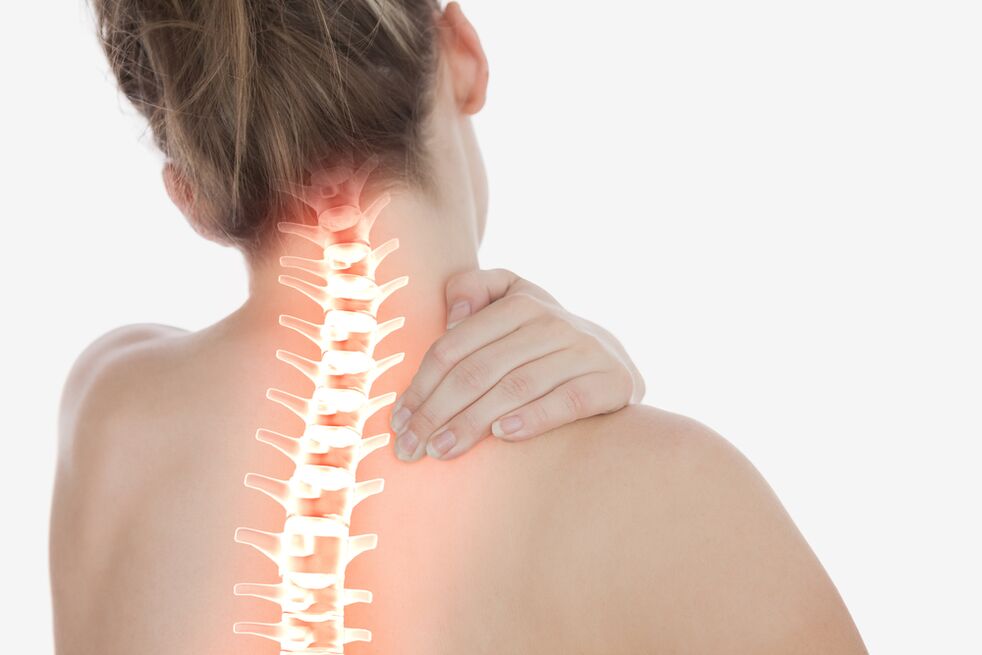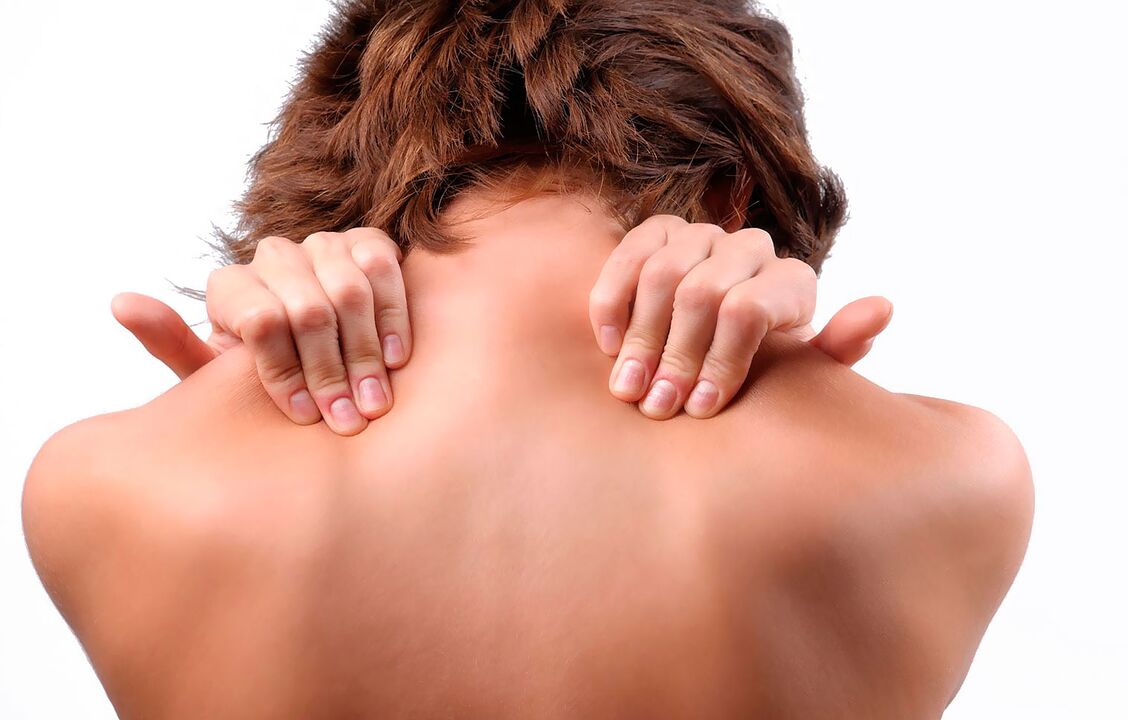Vertebral spine osteochondrosis is a disease caused by the destruction of bone tissues and cervical, thoracic and lumbar cartilage.
First of all, with the progression of the disease, the central part of the spinal disc is modified - the jet core called. For this reason, the vertebra loses some of its shock absorption properties, and refinement and cracks form in the fibrous ring along the periphery of the disc.

The additional progression of spine osteochondrosis leads to disease complications - disc protrusion or ruptures of a fibrous ring and intervertebral hernia as a consequence. The instability of the spine in the affected area leads to the pain and limited mobility of the head in cervical spine osteochondrosis, as well as limited body mobility with thoracic and lumbar spine.
In 75% of cases, it is with accuracy of spine osteochondrosis that is the cause of back pain. At age, the risk of spinal tissue dystrophy increases significantly, so on average, the symptoms of spine osteochondrosis are observed in every second inhabitant of the planet over 30 years.
The causes of spine osteochondrosis
Provocative factors in the development of spine osteochondrosis are considered back injuries or systematic back load with hard physical work or professional employment in vibration conditions. If you need to do a lot of loading and unloading work, buy a hydraulic collection for your car.
Early manifestation of symptoms of spine osteochondrosis is caused by weak physical development, flat feet or overweight. There is also a genetic predisposition in the loose structure of intervertebral discs and abnormalities of the spine structure. Intensive academy training, violating the rules for the distribution of loading on the back, a sedentary lifestyle and improper nutrition are also unfavorable in terms of spine health.
Spine osteochondrosis symptoms
The disease manifests itself as several typical symptoms. Spine osteochondrosis is characteristic: painful back pain, a sensation of numbness in the affected spine, a decrease in the amplitude of the movements, increased pain in gravity lifting, steep movement, tension during cough or sneezing.
Chronic pain, as one of the symptoms of spine osteochondrosis, causes greater fatigue. By compressing the nerve roots of the spine with the spine, the pain can be more intense and is clear. Its location in this case is not limited to the back area, but is felt by a person in the limb area.
Spine osteochondrosis stages
The stage of the disease depends on the severity of the symptoms of osteochondrosis in the spine. In the first stage of spine osteochondrosis, pain is practically not felt if only evil -light and poor spine stability by lesions. The destruction of the fibrous ring, a decrease in the size of vertebral cracks and the pain of various intensity is a symptom of second stage spine osteochondrosis.
The third stage of the disease is characterized by significant deformations of bone and vertebral tissue until the appearance of intervertebral hernias. The symptom of osteochondrosis of the more severe fourth -stage spine is mass bone growth, limited mobility, intense pain and complete or partial paralysis of limbs caused by compression of nerve roots.
Symptoms of cervical spine osteochondrosis
Cervical spine osteochondrosis usually leads to blood circulation disorders due to compression of the arteries. This leads to intense headache, dizziness and fainting. With cervical spine osteochondrosis, vertebral artery syndrome is sometimes observed. It is characterized by a feeling of noise in the head, the image of "flies" or colorful spots in front of the eyes. With cervical spine osteochondrosis, peripheral pain or hands are also possible.
Symptoms of thoracic spine osteochondrosis
Toracic spine osteochondrosis can aggravate the course of various heart pathologies. The disease causes the progression of intercision neuralgia (squeezing the nerves of the intercumo). With thoracic spine osteochondrosis, chest pain and "stake" in the center of the chest are observed.
Symptoms of lumbar spine osteochondrosis

Lumbar spine osteochondrosis leads to the development of the following diseases: Lumbago and hernia.
Ishias, as one of the complications of lumbar spine osteochondrosis, is characterized by sciatic nerve damage, gluteal pain, hypotension (reduced tone) of the calf muscles and gluteal.
With a symptom of lumbar spine osteochondrosis lumbagos, there is acute pain in the lower back, caused by displacement of the vertebrae or loss of the spinal disc.
Lumbar radiculite, another complication of lumbar spine osteochondrosis, is caused by hernias from the lower discs of the spine. It is accompanied by buttocks pain with irradiation in the back of the thigh, a hole under the knee, one leg and one foot.
Spine osteochondrosis diagnosis
The preliminary diagnosis of "spine osteochondrosis" is established by the neurologist after the initial examination of the patient's complaints on back pain and limited mobility. The spine osteochondrosis stage is verified, depending on the degree of deformation of the spine, the patient's posture and the number of disks affected.
All symptoms above spine osteochondrosis are diagnosed by feeling the patient's back. The doctor also pays attention to the state of muscle tone. As in most cases, the disease is accompanied by hypertonization of the back muscles.
Using tests to double the spine, the amplitude of the patient's movements is determined. Thanks to the use of radiography, CT and MRI, the diagnosis is specified and determined the future tactics of the treatment of spine osteochondrosis.
Treatment of spine osteochondrosis
In the treatment of spine osteochondrosis, conservative and surgical methods are used. The purpose of both is to eliminate pain syndrome and prevent an additional progression of spine deformation.
At the same time, surgical treatment of spinal osteochondrosis is used only if conservative therapy of the disease is ineffective.
The active internship of the application of conservative methods lasts an average of 2 months. At first, a short -term increase in pain syndrome caused by body reaction to medicines, physical therapy exercises (exercise therapy) and physiotherapy. In conservative treatment of spine osteochondrosis, massage, manual therapy, extract and reflexology are also used. The effectiveness of the treatment of spine osteochondrosis depends on the systematic nature of procedures and the patient's own perseverance in the execution of exercise complexes.
Surgical treatment of spinal osteochondrosis is performed with a hernia of intervertebral discs, which has long exceeds 6 months. The indication for the operation is also a reduction in gap between the vertebrae to 1/3 of the initial size and compression of the spinal cord roots.
The main method in the surgical treatment of osteochondrosis in the spine is the disco, ie removing a deformed disc. The operation can be minimally invasive using endoscopic tools using the microdisectomy method, the B-Twin system, as well as the core laser vaporization of a deformed disc.
After surgical treatment of spine osteochondrosis, a rehabilitation period for 6 months is expected. During him, the patient is directed to the treatment of sanatorium resistance to undergo a course of physiotherapy, manual therapy, acupuncture, etc.



















